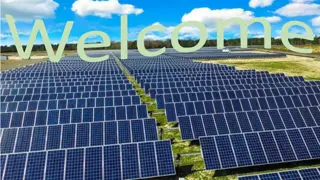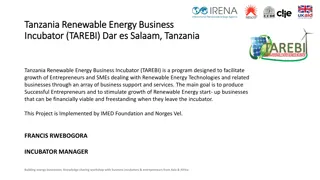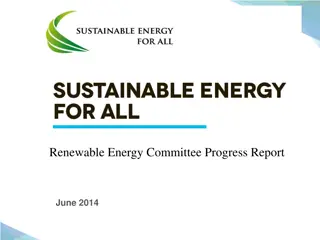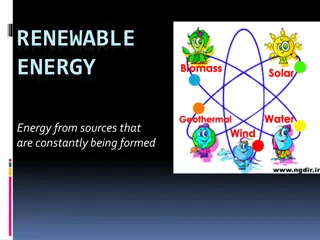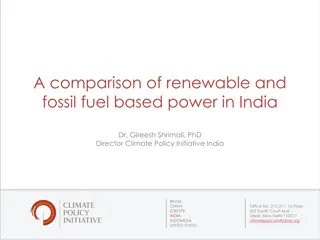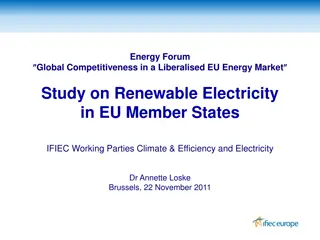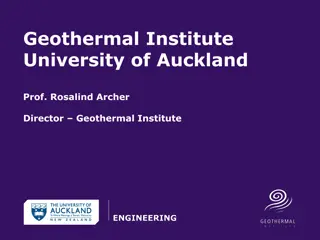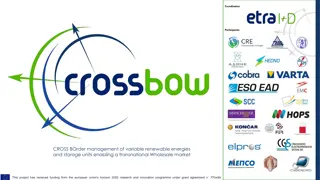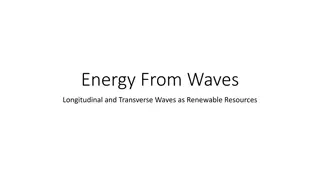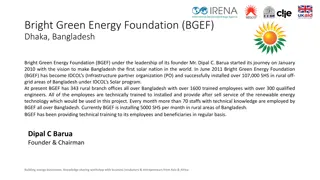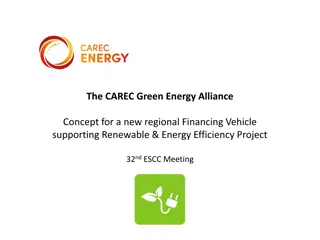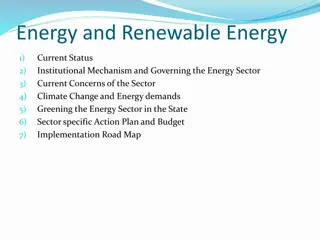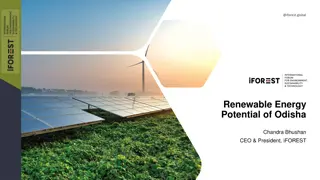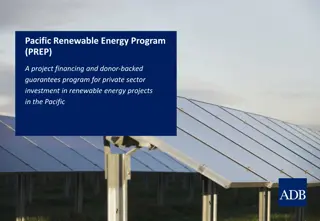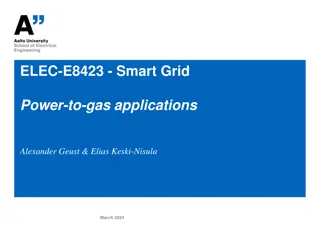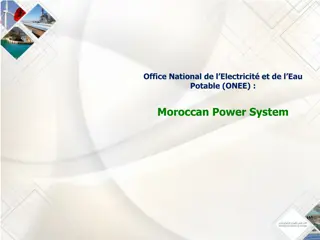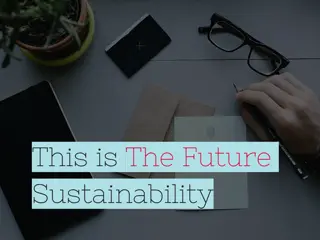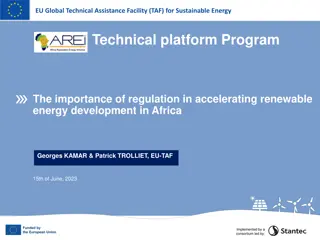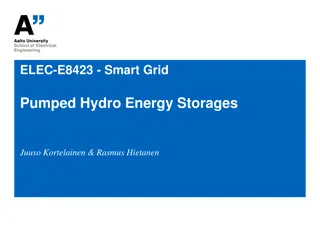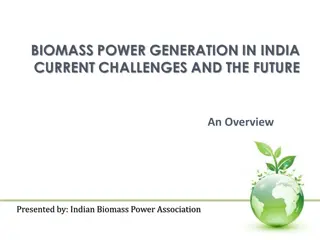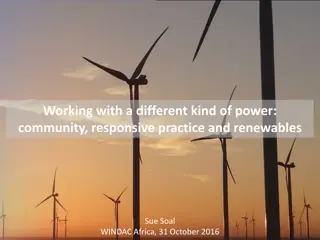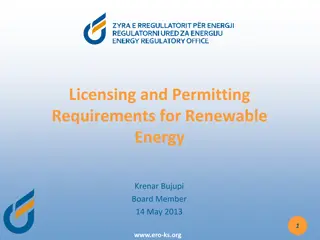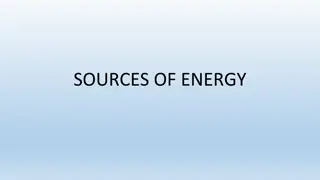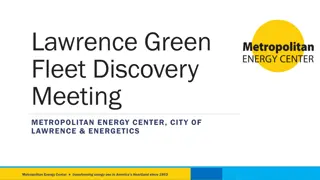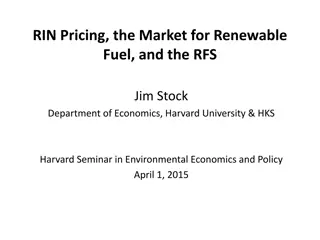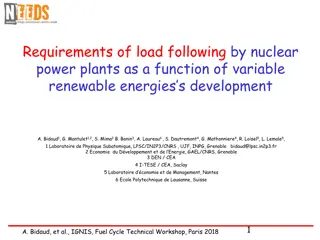Maximizing Green Energy Storage Technologies for Renewable Power
Exploring various storage technologies like Lithium-ion, Flywheels, and Hydrogen that are essential for achieving renewable energy goals by combating intermittency and enhancing grid stability. Key findings emphasize the importance of affordable and efficient storage solutions to drive sustainable energy transition.
Download Presentation

Please find below an Image/Link to download the presentation.
The content on the website is provided AS IS for your information and personal use only. It may not be sold, licensed, or shared on other websites without obtaining consent from the author. Download presentation by click this link. If you encounter any issues during the download, it is possible that the publisher has removed the file from their server.
E N D
Presentation Transcript
Creating staying power for green energy 1
Storage Technology Comparisons Build Time Efficiency Cap Cost, $/KWh Discharge Time Pumped Storage 9-15 yrs 80 100 1-12hr CAES 3+ yr 55 80 1hr-days Flow Batteries 6 mo 80 200 seconds-8hr Li Ion 6 mo 85 400 seconds-8hr Capacitors 2 mo 99 8000 seconds-minutes Fly Wheels 1 yr 95 1000 minutes to 4hr Slurry 2-3 yr 40 10 1-1000hr 2
Todays Storage Applications Frequency and voltage control Ramping Control Peak Load Shaving Removing Intermittency from Renewables (Grid? Storage) 3
Today Renewable energy requires fossil fuel backup generation Behind every wind farm is a massive fossil fuel infrastructure to provide backup power when the skies are still. Wind farms require dispatchable fossil fuel plants of the same output to standby and be ready to generate when wind output falls. No matter how many wind farms we build, we will never achieve full renewable energy generation from wind without some kind of storage capability that is affordable and clean. 5
Key Findings in Grid Storage Massive Amounts of Storage are needed to remove Intermittency The Number of Cycles per Year is about 3 Today s Technologies do not work Economically 6
Hydrogen is the key The National Renewable Energy Laboratory has stated publicly that hydrogen is the key to deeply de-carbonizing our electric grid. 7
Hydrogen Storage Technologies Compressed Liquefied Metal Hydrides 8
Hydrogen Storage Comparisons Compressed Hydrogen? Storage Liquid? Hydrogen Storage MgH2? Slurry Hydrogen Storage Production? Rate? Days? of? storage Storage? Capacity Inflation? rate Total? Capital? Cost (kg/hr) (Days) (kg) (%) ($) ? ? ? ? ? ? ? ? ? ? ? ? ? ? ? ? ? ? ? ? ? ? ? ? ? ? ? ? ? ? ? ? ? ? ? ? ? ? ? ? ? ? ? ? ? ? ? ? ? ? ? ? ? ? ? ? ? ? ? ? ? ? ? ? ? ? ? ? ? ? ? ? ? ? ? ? ? ? 7,935 40.4 ? ? ? ? ? ? ? ? ? ? ? ? ? ? ? ? ? ? ? ? ? ? ? ? ? ? ? ? ? ? ? ? ? ? ? ? ? ? ? ? ? ? ? ? ? ? ? ? ? ? ? ? ? ? ? ? ? ? ? ? ? ? ? ? ? ? ? ? ? ? ? ? ? ? ? ? ? ? 7,935 40.4 ? ? ? ? ? ? ? ? ? ? ? ? ? ? ? ? ? ? ? ? ? ? ? ? ? ? ? ? ? ? ? ? ? ? ? ? ? ? ? ? ? ? ? ? ? ? ? ? ? ? ? ? ? ? ? ? ? ? ? ? ? ? ? ? ? ? ? ? ? ? ? ? ? ? ? ? ? ? ? ? ? ? 7,935 40 7,700,000 8,005,122 7,700,000 3.0% 3.0% 3.0% 1,462,697,250 ? ? ? ? ? ? ? ? ? ? ? ? ? ? ? ? ? ? ? ? ? ? ? ? ? ? ? ? ? 432,877,828 ? ? ? ? ? ? ? ? ? ? ? ? ? ? ? ? 558,790,340 Annual? Depreciation Annual? Electricity? Cost Annual? Cooling? Water? Cost ($/yr) Total? Annual? Cost ($/yr) ($/yr) ? ? ? ? ? ? ? ? ? ? ? ? ? ? ? ? ? ? ? ? ? ? ? ? ? ? ? ? ? ? ? ? ? ? ? ? ? ? ? ? ? ? ? ? ? ? ? ? ? ? ? ? ? ? ? ? ? ? ? ? ? ? ? ? ? ? ? ? ? ? ? ? ? ? ? ? ? ? ? ? ? ? 66,486,239 7,347,345 61,718 73,895,302 ? ? ? ? ? ? ? ? ? ? ? ? ? ? ? ? ? ? ? ? ? ? ? ? ? ? ? ? ? ? ? ? ? ? ? ? ? ? ? ? ? ? ? ? ? ? ? ? ? ? ? ? ? ? ? ? ? ? ? ? ? ? ? ? ? ? ? ? ? ? ? ? ? ? ? ? ? ? 19,676,265 34,373,217 802,042 54,851,523 ? ? ? ? ? ? ? ? ? ? ? ? ? ? ? ? ? ? ? ? ? ? ? ? ? ? ? ? ? ? ? ? ? ? ? ? ? ? ? ? ? ? ? ? ? ? ? ? ? ? ? ? ? ? ? ? ? ? ? ? ? ? ? ? ? ? ? ? ? ? ? ? ? ? ? ? ? ? ? ? ? ? 25,399,561 5,560,873 46,711 31,007,146 ($/yr) Net? Present? Worth $ $1,910,722,839 $824,792,622 $751,783,330 9
The Slurry Magnesium particles Suspended in mineral oil 10
The Chemistry Mg + H2 MgH2 The reaction is reversible Pressure drives it to the right Heat drives it to the left 11
Safe Hydrogen creates two pathways for wind power Electricity Electric Distribution ` Slurry System Hydrogen Gas Turbine Electrolyzer H2 H2 12
Renewables have an intermittency problem The biggest obstacle to complete replacement of fossil fuel plants by wind farms is intermittency: The supply of energy must be constant or dispatchable, even at times of no wind. Wind farm output is below maximum generation about 80% of the time. That is why there must be fossil fuel plants to back up wind farms until now. 13
The Storage Solution To create a reliable supply of energy from renewables, some of the energy must be stored for use during times of low output. With storage, a wind farm can become a dispatchable plant controlled just like a fossil fuel plant With storage, a wind farm becomes a reliable, constant source of energy 14
Safe Hydrogens solution Only with Safe Hydrogen can storage become a clean, dependable, economically viable way to eliminate carbon from electricity generation Safe Hydrogen s solution will not just capture a large share of the existing need, it will lead to a dramatic growth in the wind power market 15
Safe Hydrogens solution works The Safe Hydrogen storage system has a much lower capital cost per KWh: It is $10 per KWh stored. A $800 million wind farm would require a $1 billion storage system, far cheaper than any alternative available today. To get a 10% IRR on the total investment including the wind turbines, one would charge consumers approximately $0.10 per KWh, which is approximately the current average price. 16
IRR vs Contract Price 35% Baseload 150MW Dispatchable 150MW 30% Internal Rate of Return 25% 20% 15% 10% 5% 0% 0 100 Contract Price ($/MWh) 200 300 400 17
References Reference 1 - Webinar: H2@Scale: Deeply De-Carbonizing our Energy System, Bryan Pivovar, NREL, July 28, 2016 Reference 2 - Magnesium Hydride Slurry: A Better Answer to Hydrogen Storage, Andrew McClaine, Kenneth Brown, David Bowen, ASME Journal of Energy Resources Technology NOVEMBER 2015, Vol. 137 Reference 3 - Economic top down evaluation of the costs of energy storages A simple economic truth in two equations, Christoph Rathgeber, Eberhard L vemann, Andreas Hauer, Bavarian Center for Applied Energy Research ZAE Bayern, Walther-Mei ner-Str. 6, 85748 Garching, Germany (2015) Reference 4 www.safehydrogen.com/technology.html 21
Contact Information Ken Brown Managing Partner, Safe Hydrogen, LLC 781 572 0334 kbrown@safehydrogen.com www.safehydrogen.com 22



